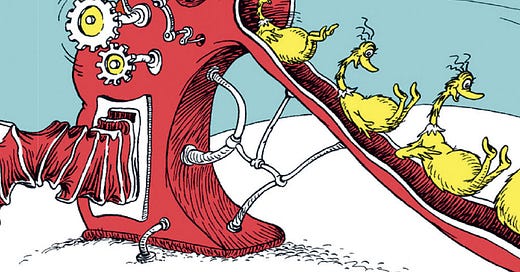Tried to write an email to my folks explaining some generational politics but I lost my train of thought.
Originally published in Civilization #5, 2021
Early in the 20th century, when you walked into an office, you could easily tell who was the boss and who was the secretary. There were many visual cues about where people sat and what they wore. Suit and tie = boss. Uniform = janitor. The hierarchies were very VISIBLE. This felt humiliating to the less powerful. It became quite clear to them that, as individuals, being a cog in a machine (especially a war machine) was not in their personal interest, and they were right. Nobody was looking out for them, so they had to look out for themselves. They became consumed with their internal spiritual lives and self-actualization. They began burning their bras, growing their hair long, and refusing to wear suits in protest against the establishment. It was actually really cool. There are some good songs about it.
Although this movement was reactionary and non-conformist, the overarching ethos was pacifism and passivity. In the face of real violence (pigs with guns), their protests were non-violent—expressing dissent through complex choreography performed for the cameras. They developed an aesthetic of disengagement—casualness, self-reliance, improvisation, and psychedelics. Culturally, real anger got displaced onto optics—an aesthetic battle between hip and square.
You’ll never believe what happened next, though! It’s shocking, but...form disassociated from meaning. Dr. Seuss wrote a great book about it called The Sneetches. Basically, aesthetics are really easy to replicate, and capitalism is a totalizing system, so industry began to produce commodities that adhered to counterculture tastes. This is called commodifying dissent and selling it back for profit at Urban Outfitters. The resulting semiology gets really complicated with the squares dressing cool and the cool kids dressing like squares until you can’t tell them apart.
A series of postmodern aesthetic movements over subsequent decades mount attacks on mainstream culture—punk, grunge, rave—none of them work because aesthetic movements don’t work. Squares just snatch them up! The final movement, hipsterdom, incited by Malcolm Gladwell, turns teens into corporate psyops, and the transformation is complete. Shopping displaces voting. The consumer replaces the citizen. Buying a Subaru and drinking a cappuccino are repositioned through advertising as a protest. But it’s a mistake to confuse dissent and shopping. It’s just marketing. There is no ethical consumption under capitalism.
These days, megalomaniac surveillance billionaires wear hoodies to work. Offices allow dogs and serve beer on tap. There is an aesthetic casualness to the culture, an appearance of egalitarianism, but it’s an illusion. The powerful still hold power. The boss is still the boss but the scaffolding is invisible. Nothing is what it seems, so suspicion is the default mode. (This is why everyone is preoccupied with unearthing ulterior motives—think cancel culture and conspiracies—finding patterns in the chaos.) The medium has subsumed the message entirely. Any dissent expressed aesthetically reads as pure aesthetics.
The MAGA hat—the best piece of design so far this century—represented Trump’s triumph over aesthetics. Not folksy like the knitted pussy hat, not slick and high-concept like Hillary’s Woman Card, it looks like it was ordered from Zazzle—like he didn’t bother to design it at all. Why? He is attacking aesthetics itself.
It strikes me that Gen Z has embraced the language of sus and random. Sus, short for suspicious, is negative. It expresses fear of ulterior motives—an imagined inscrutable author. Random is positive and imagines no motives at all. It’s very DADA!
A boomer told me a famous zen story about being in a boat that gets hit by another boat—and feeling angry until you discover the other boat is empty. With no one to blame, the anger dissipates. But what if you never know what’s in the other boat? What if there is no way of finding out? What if you are left wondering?
This was originally published Civilization #5




